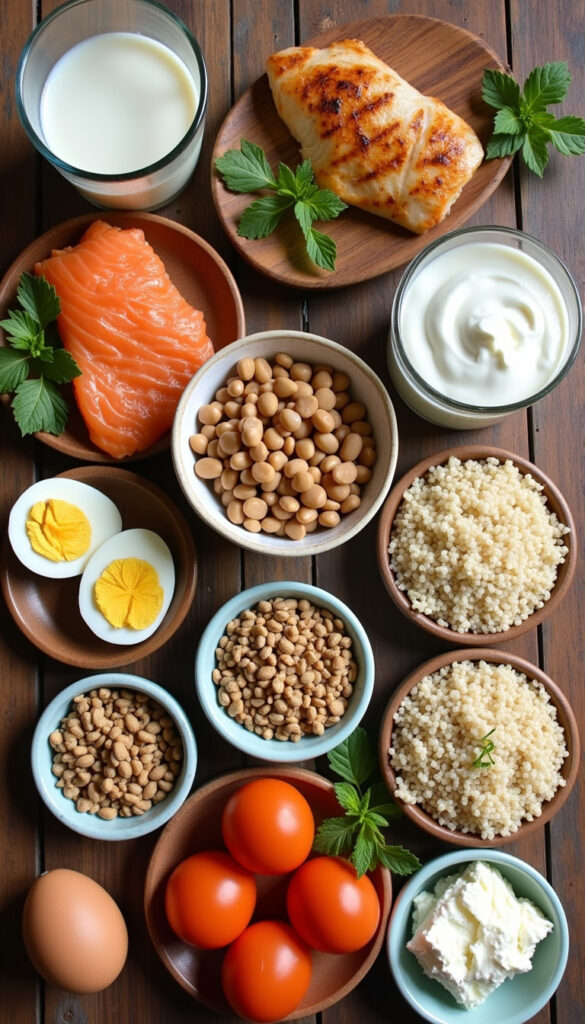Lysine rich foods play a vital role in your body’s protein building and immune system health, yet many people don’t get enough of this essential amino acid daily.

What Is Lysine and Why Do You Need It?
Lysine is an essential amino acid that your body cannot make on its own. You must get it from the foods you eat. This powerful nutrient helps your body build proteins, absorb calcium, and fight off infections. Your body uses lysine for many important jobs:
- Building muscle tissue
- Making collagen for healthy skin
- Healing wounds faster
- Fighting cold sores and other viral infections
- Absorbing calcium for strong bones
- Producing hormones and enzymes
Without enough lysine in your diet, you might feel tired, get sick more often, or have trouble healing from cuts and bruises. That’s why eating lysine rich foods every day is so important for your health.
How Much Lysine Do You Need Daily?
The amount of lysine you need depends on your age and weight. Here’s what health experts recommend:
- Adults: 38 mg per kilogram of body weight
- Children (4-8 years): 58 mg per kilogram of body weight
- Teens (9-18 years): 44 mg per kilogram of body weight
For an average adult weighing 150 pounds, this means you need about 2,600 mg of lysine each day. Most people can easily meet this need by eating a variety of lysine rich foods.
Top Animal-Based Lysine Rich Foods
Animal proteins contain all essential amino acids, including high amounts of lysine. These foods are some of the best sources you can find.
Meat and Poultry
Red meat and poultry are excellent sources of lysine. A 3-ounce serving provides:
- Chicken breast: 2,800 mg
- Turkey: 2,400 mg
- Lean beef: 2,200 mg
- Pork chops: 2,000 mg
- Ground beef (lean): 1,900 mg
Choose lean cuts when possible to get the most lysine without too much saturated fat. Grilling, baking, or broiling these meats helps keep them healthy.
Fish and Seafood
Fish and seafood are not only rich in lysine but also provide healthy omega-3 fats. Top choices include:
- Tuna: 2,600 mg per 3-ounce serving
- Salmon: 2,400 mg per 3-ounce serving
- Cod: 2,200 mg per 3-ounce serving
- Shrimp: 1,800 mg per 3-ounce serving
- Crab: 1,600 mg per 3-ounce serving
Fresh, frozen, or canned fish all provide good amounts of lysine. Just watch out for added salt in canned varieties.
Dairy Products
Dairy foods are great sources of lysine and calcium. You can easily add these to meals and snacks:
- Greek yogurt (1 cup): 1,500 mg
- Cottage cheese (1 cup): 1,400 mg
- Milk (1 cup): 700 mg
- Cheddar cheese (1 ounce): 200 mg
- Eggs (1 large): 450 mg
Low-fat dairy options give you lysine without too many calories from fat.
Plant-Based Lysine Rich Foods
If you eat a vegetarian or vegan diet, you can still get plenty of lysine from plant foods. Some plants are surprisingly high in this essential amino acid.
Legumes and Beans
Beans and legumes are among the best plant sources of lysine. They’re also high in fiber and other nutrients:
- Lentils (1 cup cooked): 1,200 mg
- Black beans (1 cup cooked): 900 mg
- Chickpeas (1 cup cooked): 800 mg
- Kidney beans (1 cup cooked): 700 mg
- Lima beans (1 cup cooked): 600 mg
- Peanuts (1 ounce): 300 mg
Try adding beans to soups, salads, and rice dishes for extra lysine and protein.
Quinoa and Ancient Grains
Most grains are low in lysine, but quinoa is different. This superfood grain contains all essential amino acids:
- Quinoa (1 cup cooked): 450 mg
- Amaranth (1 cup cooked): 400 mg
- Buckwheat (1 cup cooked): 200 mg
These grains make great substitutes for rice or pasta in your favorite dishes.
Seeds and Nuts
While not as high in lysine as animal foods, some seeds and nuts can help boost your intake:
- Pumpkin seeds (1 ounce): 350 mg
- Pistachios (1 ounce): 300 mg
- Cashews (1 ounce): 200 mg
- Sunflower seeds (1 ounce): 150 mg
Sprinkle these on salads, yogurt, or oatmeal for extra lysine and crunch.
Foods That May Block Lysine Absorption
Some foods can interfere with how well your body uses lysine. The amino acid arginine competes with lysine for absorption. Foods high in arginine include:
- Chocolate and cocoa
- Nuts (especially almonds and walnuts)
- Seeds
- Oats
- Wheat germ
You don’t need to avoid these foods completely. Just make sure you’re eating plenty of lysine rich foods too, especially if you’re trying to prevent cold sores or boost your immune system.
Easy Ways to Add More Lysine to Your Diet
Getting enough lysine doesn’t have to be complicated. Here are simple ways to boost your daily intake:
Breakfast Ideas
- Add Greek yogurt to your morning routine
- Make scrambled eggs with cottage cheese
- Try quinoa breakfast bowls with fruit
- Blend protein-rich smoothies with milk
Lunch Options
- Pack tuna or chicken salad sandwiches
- Make lentil or bean soups
- Choose quinoa salads over regular grain salads
- Add hard-boiled eggs to your greens
Dinner Solutions
- Include fish, chicken, or lean meat as your main protein
- Make bean and rice combinations
- Try quinoa as a side dish
- Add legumes to pasta dishes
Snack Ideas
- Keep Greek yogurt cups handy
- Make trail mix with pumpkin seeds
- Try cottage cheese with fruit
- Snack on hard-boiled eggs
Special Considerations for Different Diets
Vegetarian Diets
If you don’t eat meat, focus on combining different plant proteins throughout the day. Eating beans with grains helps create complete proteins with all essential amino acids.
Vegan Diets
Plant-based eaters need to be more careful about lysine intake. Make sure to eat plenty of legumes, quinoa, and lysine-rich vegetables daily.
Gluten-Free Diets
Many gluten-free people rely heavily on rice, which is low in lysine. Include more quinoa, beans, and animal proteins if you eat them.
Signs You Might Need More Lysine
Your body will give you signals if you’re not getting enough lysine:
- Getting sick often
- Slow wound healing
- Feeling tired all the time
- Hair loss or thinning
- Frequent cold sores
- Poor concentration
- Mood changes
If you notice these signs, try adding more lysine rich foods to your meals. Talk to your doctor if problems continue.
Tips for Meal Planning with Lysine
Planning your meals around lysine rich foods helps ensure you get enough every day: 1. Include a high-lysine protein at each meal 2. Combine beans and grains for complete plant proteins 3. Keep lysine-rich snacks available 4. Plan weekly menus that include variety 5. Prep ingredients ahead of time for easy cooking
The Bottom Line
Eating enough lysine is easier than you might think. Whether you prefer animal proteins or plant-based options, many delicious foods can help you meet your daily needs. Focus on including a variety of lysine rich foods throughout your day rather than trying to get it all from one source. Mix different protein sources, add plenty of fruits and vegetables, and enjoy whole grains for the best nutrition.

Lifebing is driven by an unrelenting passion for promoting health and well-being, our team is wholly committed to curating exceptional content and immersive experiences.
